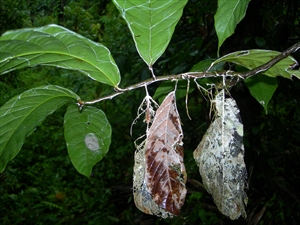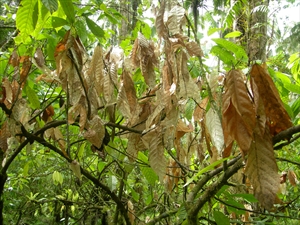White thread
Pacific Pests, Pathogens, Weeds & Pesticides - Online edition
Pacific Pests, Pathogens, Weeds & Pesticides
Cocoa white thread (015)
Marasmiellus (Marasmius) scandens
Asia, Africa, South America, the Caribbean, Oceania. It is recorded from Fiji (cocoa, coffee), Papua New Guinea (cocoa), and Solomon Islands (cocoa).
Cocoa is the main host, but it is recorded on many other trees and shrubs.
The life cycle of this fungus has not been fully described. The white threads are a collection of strands of the fungus, and these grow over branches and leaves (Photos 1&2). The fungus produces toadstools, and these produces spores. However, the toadstools are not often seen.
Spread of the fungus is thought to occur as follows:
- It grows along the branches as white threads, extending onto the leaf stalks and then over the surface of the leaf blades, which turn brown and die.
- It spreads from tree to tree when branches of shade trees infected with the fungus fall on the cocoa trees below.
- As airborne spores released from toadstools that form in wet weather.
As the leaves are infected, they turn dark brown and die (Photo 3), but even though they are no longer attached to the branches, they remain suspended in place by the threads of the fungus (Photo 2).
White thread is a disease associated with poor tree maintenance. If management is poor, the fungus can destroy large numbers of leaves, but the impact on yield has not been recorded. Normally, the disease is of little economic importance as it is controlled by hygiene measures.
Look for the white strands of the fungus along the branches; look for patches of dead leaves, held in place by white threads. The fungus can be more clearly seen over the branches and leaf blades when they are wet. Compare with other thread blights, e.g., Pellicularia koleroga (see Fact Sheet no. 199) and horsehair blight (see Fact Sheet no. 05).
CULTURAL CONTROL
During growth:
- Prune out the infected leaves and branches; this is the best way of managing outbreaks of white thread. The prunings should be taken out of the plantation and burnt.
- Make regular inspections for the disease, at least every 3 months.
CHEMICAL CONTROL
Chemical control is not recommended for this disease.
AUTHORS Helen Tsatsia & Grahame Jackson
Information from CABI (2020) Marasmiellus scandens (white thread blight). Crop Protection Compendium. (https://www.cabi.org/cpc/datasheet/32537); CABI (undated) Plantwise Knowledge Bank. (https://www.plantwise.org/knowledgebank/datasheet/32537#SymptomsSection); and from Amoako-Attah L, et al. (2016) White thread blight disease caused by Marasmiellus scandens (Massee) Dennis & Reid on cocoa and its control in Ghana. African Journal of Agricultural Research 11(50): 5064-5070. (https://academicjournals.org/journal/AJAR/article-abstract/786B84F62138).
Produced with support from the Australian Centre for International Agricultural Research under project PC/2010/090: Strengthening integrated crop management research in the Pacific Islands in support of sustainable intensification of high-value crop production, implemented by the University of Queensland and the Secretariat of the Pacific Community.






